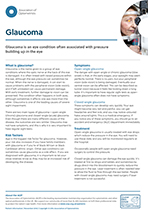Glaucoma
Glaucoma is an eye condition often associated with pressure building up in the eye
What is glaucoma?
Glaucoma is the name given to a group of eye conditions where the optic nerve at the back of the eye is damaged. It is often linked with raised pressure within the eye, although the eye pressure can sometimes be normal. When the nerve is damaged, it can start to cause problems with the peripheral vision (side vision) and, if left untreated, can cause permanent damage. With early treatment, further damage to vision can be prevented. The condition often happens in both eyes, although sometimes it affects one eye more than the other. Glaucoma is one of the leading causes of severe sight impairment.
There are two main types of glaucoma – open-angle (chronic) glaucoma and closed-angle (acute) glaucoma. Even though there are many different causes of the disease, the outcomes are very similar. Glaucoma may not have symptoms and this is why it is very important to have regular sight tests.
Risk factors
Age is the biggest risk factor for glaucoma. However, your risk also increases if you have family members with glaucoma or if you’re of black African or black Caribbean ethnic origin. Other eye conditions can sometimes cause glaucoma as a side effect. If you are diagnosed with glaucoma, it is important to let your close relatives know as they may be at increased risk of developing the disease.
Symptoms
Open-angle glaucoma
The danger with open-angle or chronic glaucoma (slow onset) is that, in the early stages, your eyesight may seem perfectly normal. There is no pain, but your peripheral vision (side vision) is being damaged. Eventually, your central vision can be affected. This can be described as tunnel vision because it feels like looking down a long tube. It’s important to have regular sight tests as open-angle glaucoma often does not have symptoms.
Closed-angle glaucoma
These symptoms can develop very quickly. Your eye might become very red and painful, you can get headaches and feel sick, and you may notice coloured halos around lights. This is a medical emergency. If you notice any of these symptoms, you should go to an accident and emergency (A&E) department immediately.
Treatment
Open-angle glaucoma is usually treated with eye drops which reduce the pressure in the eye. You will need to use these daily and you will be monitored regularly at the hospital. Occasionally people with open-angle glaucoma need surgery to control the pressure.
Closed-angle glaucoma can damage the eye quickly. It’s treated at first by drops and tablets and sometimes by drugs direct into the bloodstream to quickly reduce the pressure in the eye. Laser treatment is often needed later to allow the fluid to flow through the eye better. People with closed-angle glaucoma may need surgery if laser treatment is not successful.
Resources for your practice
You can download our patient leaflet on glaucoma.
If you're a practitioner, we recommend that you use this information, following a suitable examination, to reinforce advice given to the patient who has presented with symptoms of glaucoma.
For more information on eye health, go to our For patients section.


